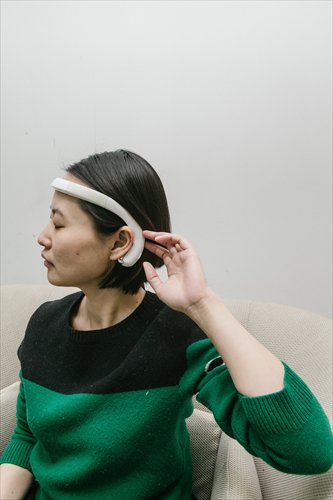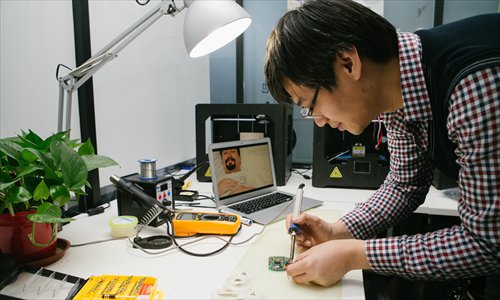Are these new therapeutic devices a medical miracle or the Emperor’s new cloak?

More kinds of wearable therapeutic devices are currently being produced to cater to growing demand for at-home medical treatment, but both doctors and industry experts have warned that users should keep an eye out for false advertising claims. Photo: Li Hao/GT
It was after his promotion last year at the investment bank where he works that Zhang Ming (pseudonym), 33, began noticing problems.
All of sudden, he found that while talking with colleagues, he could no longer remember the names of their clients. What's worse, at night he was unable to stop thinking about his work, which often resulted in either insomnia or a night of fitful sleep, something he'd never encountered before.
That went on until this January, when a friend recommended a wearable device designed to help relieve stress, anxiety and insomnia. The first time he tried it, Zhang says, he thought he'd found a cure.
"When I put the device around my head, I gradually felt more relaxed, like I was falling into a state of meditation, and then had a sound sleep, which was amazing," said Zhang, who now uses the device almost every night, both at home and on business trips.
In recent years, more and more wearable devices that claim to cure illnesses, especially chronic conditions, such as persistent pain, sleeping problems and diabetes, have hit the market, touting themselves as a new, easier alternative to seeing the doctor.
It's a market with big potential. According to a December article on mddionline.com, an American news portal focused on medical devices and the diagnostic industry, a recent market research report projects that the global health and wearable medical technology market will grow from about $3.5 billion in 2014 to about $17 billion by 2022.
It added that although the diagnostics and monitoring segment has so far seen the biggest revenue, wearable therapeutic technologies are expected to be the fastest-growing segment, with a projected annual growth rate of 23 percent. Among the most-anticipated devices in this segment that the article mentions are one that can aid with quitting smoking and another that can help ease joint and back pain.
Though devices like these have been exploding in popularity of late, with their convenience offering great space for development, medical experts say that the industry remains at a germinal stage, and there are still concerns that must be addressed over these technologies' effectiveness and sustainability.

Zhang Bo, the CEO of Beijing-based Gold-NOAH Technology Corporation, makes adjustments to one of their products, a wearable device designed to cure sleeping problems. Photo: Li Hao/GT
Offering more than just monitoring
Zhang has used wearable devices before, such as smart wristbands that are able to monitor the wearer's heartrate, movements and sleep quality, but to his disappointment, they didn't do much to solve his sleeping problems.
"Wearable monitoring devices can give me a lot of data, but it is not very useful," he said. That's why when he first heard about a wearable device capable of curing insomnia, he showed great interest.
Zhang recalled that when he first used the device, which is worn like a headset, he still could not stop the usual bombardment of thoughts.
But after the device had gotten a chance to monitor his brain waves and transmit a combination of sounds, lights and vibrations designed to change those waves, the stress and anxiety began to melt away, his mind went blank and he dozed off, safe and sound.
By the time he talked with the Metropolitan, Zhang had been using the device for almost one month, and even recommended it to friends suffering from similar problems.
"Compared with wearable monitoring devices, which are more popular, therapeutic ones are just emerging," said Li Wei, who works at the China Food and Drug Administration (CFDA) and has also written on medical devices for his column on cn-healthcare.com, a Chinese health news portal.
"But these devices have greater potential for a positive impact, as they could extend treatments for some kinds of diseases, especially chronic diseases, from the hospital to one's home."
Li added that compared with abroad, China has relatively few kinds of wearable therapeutic devices, with those available aimed mainly at treating sleep disorders, constipation, breast diseases, hypertension and cervical spondylosis, a condition that affects the bones, discs and joints of the neck.
More flashy than practical?
Despite the market's ever-accelerating growth, some patients have complained that too many devices have more flash than use.
For example, after several attempts to use a device that claims to cure cervical spondylosis, Zou Xu (pseudonym), a 31-year-old magazine editor in Beijing, has given up.
Zou has suffered from the disorder, which affects the cartilage and bones in the neck, causing chronic pain, for almost two years due to long periods sitting in front of his computer.
Over that time, he's tried both Western medicine and traditional Chinese medicine treatments, all to no avail.
That's why he was pleased on the New Year's Day to receive the device as a gift from a friend, but to his disappointment, it hasn't had much effect.
"When you use it, you can feel a sting or vibration on your back, which is supposed to create the effect of an acupuncture needle, but that's it," he says.
Zou says that, like him, many people are becoming interested in wearable therapeutic devices because of their beautiful design, convenience and supposed technological advances, but added that if consumers don't see results, they will quickly lose confidence.
"Actually many of the products are not as 'effective' and 'smart' as they advertise," said Zou.
Right now, the market is just starting to take off. If you search "wearable devices, cervical spondylosis" on Taobao, China's largest e-commerce platform, more than 200 product results pop up, with prices ranging from 189 yuan ($29) to over 3,000 yuan.
"You see many new products coming out every now and then, but as these devices are still in their initial stage of development, they are facing two challenges: effectiveness and sustainability," said Li.
He added that, at this stage, many wearable medical devices, including therapeutic ones, are like vases - they look nice, but they're not very useful. "Although they are marketed as being 'smart,' they are not smart enough," he said. "They can not provide different treatments according to patients' different conditions."
As for sustainability, Li said, "Many users don't use the devices for extended periods of time. One reason is that they are not 'smart' enough, and the other is that they are not in accord with users' habits, which means that they have to further improve the user experience."
The future of wearable therapeutic devices
In the face of a lack of regulation, some industrial and medical experts have expressed hopes that the government would strengthen supervision over the market, as well as patients be taught to judge good products from bad.
Zhang Bo, the founder and CEO of Beijing-based wearable medical devices company Gold-NOAH Technology Corporation, told Metropolitan that the value of wearable therapeutic devices lies in the fact that they can deliver more precise treatment thanks to their access to big data and cloud technology. That does not mean, however, that they can cure every condition.
"Right now, many products are deploying exaggerated or unrealistic advertising claims to seize more of the market," said Zhang Bo, who spent 12 years working in the medical industry.
"Some of them wrongly think that by connecting with WIFI or Bluetooth, these devices can be called 'smart.' That's making it harder for common people to judge and choose from these products."
The process to receive clinical verification from the CFDA as a therapeutic device takes at least a year and a half. Some companies are sidestepping this process by registering their devices as healthcare products, which require only a month or two to get a permit, but advertising them as therapeutic products. As such, Zhang Bo says, the government should strengthen supervision over false claims in the market.
Yang Xiaowen, a sleep expert who is a visiting scholar at Beth Israel Deaconess Medical Center, a teaching hospital of Harvard Medical School, added that patients should know that they can only trust products that have received CFDA's clinical verification.
She added that patients should also be aware that such devices are no replacement for an actual doctor, but merely a supplement to treatment. Even in the future, they will likely act more as a complement to traditional medicine rather than a replacement.
"Ten years from now, the use of wearable medical devices for monitoring, diagnosis and treatment at home will become common," she says.
"They will also help doctors treat patients remotely, which will greatly reduce the frequency that people need to go see the doctor in person."
Newspaper headline: Wearing the cure